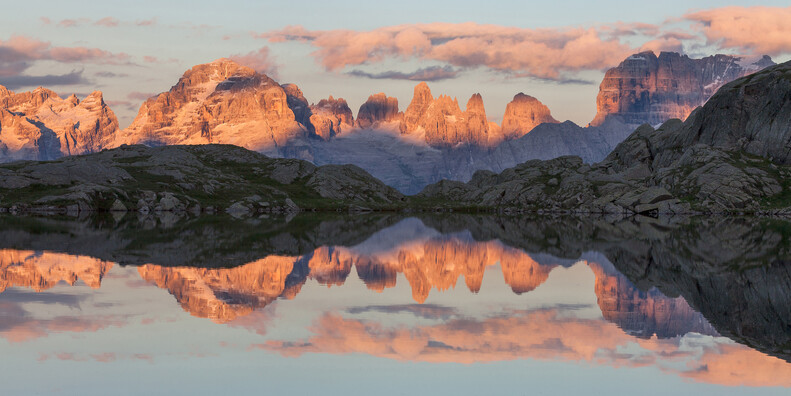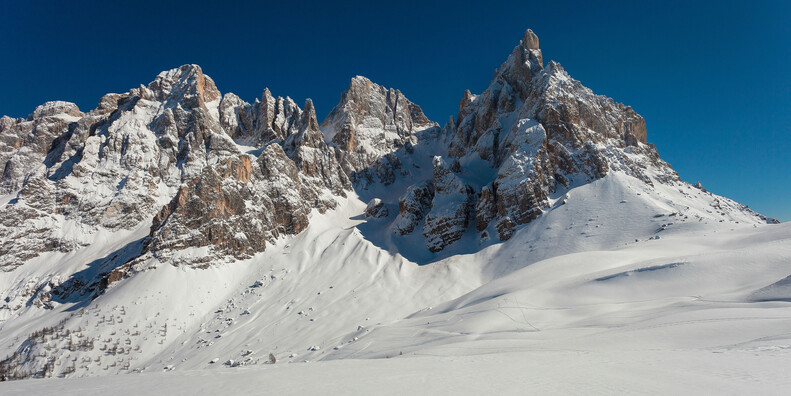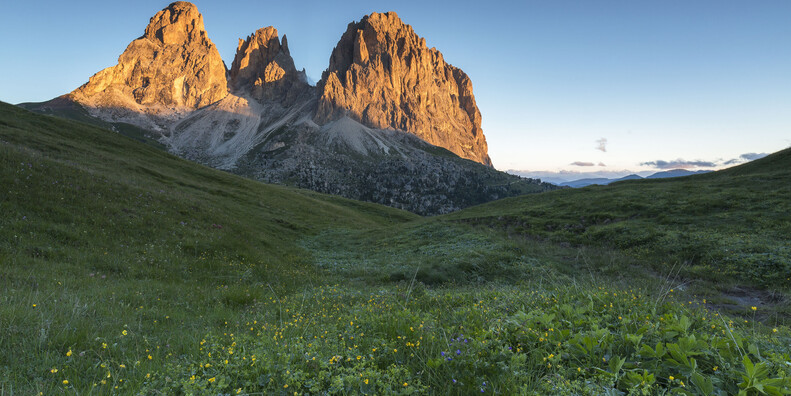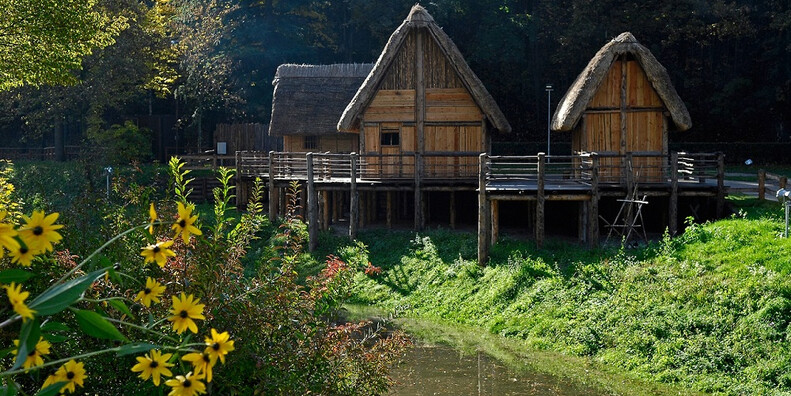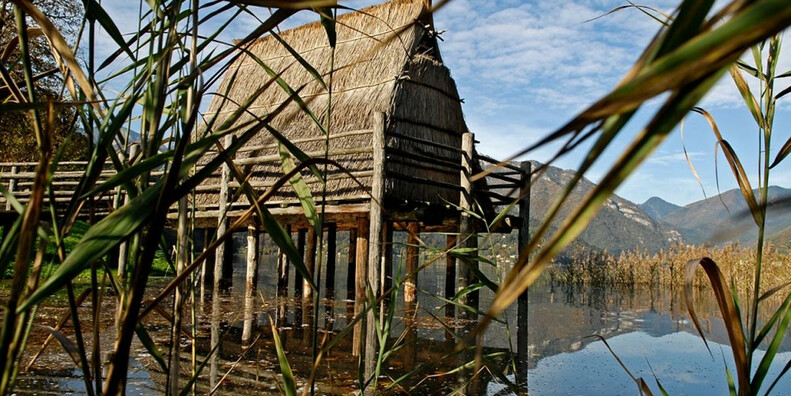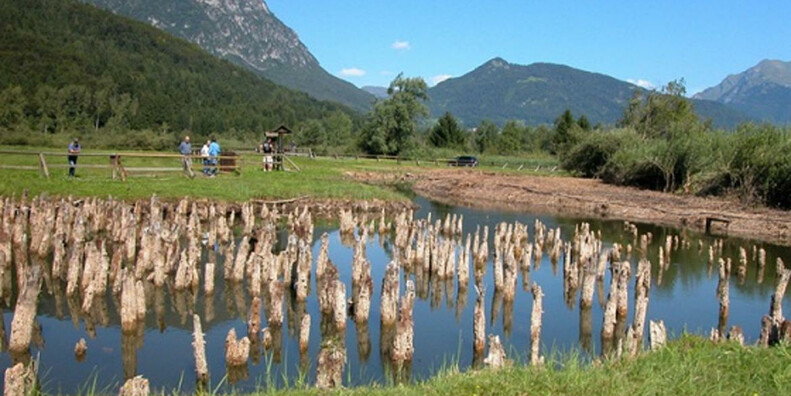DISCOVERING THE DOLOMITES UNESCO WORLD HERITAGE SITE
To the west is the Brenta Group, to the east the Latemar, the Catinaccio (Rosengarten), the Pale di San Martino and the Marmolada, which at 3,342 metres is the Queen of the “Pale Mountains”. At their feet are communities with their own cultures and traditions, constantly seeking a balance between development and protecting a unique natural heritage
The essence of the Dolomites lies in its rocks: they create its slender forms (described by Le Corbusier as "the most beautiful architecture in the world"), which are whimsical and daring, and take on a rainbow of colours that change constantly throughout the day until the final spectacle of the alpenglow.
The present-day appearance of the Pale Mountains is the result of a long and fascinating geological history that has shaped them, beginning 280 million years ago. Back then, they were not yet mountains, but an alluvial plain overlooking a gulf of tropical sea known as Tethys located between Europe and Africa, which were still united in Pangaea. In the Permian era, the plain first sank into the Tethys Sea, which flooded the area of the present-day Dolomite region. The waters were shallow and warm, similar to parts of the present-day tropics, and was home to communities of microorganisms with the ability to fix mineral salts and stabilise the various layers of sediment in their skeleton. From the Triassic onwards, the depth of this sea changed several times. Each time it dropped, a large number of these micro-organisms triggered the construction of a massive reef to counteract the sinking of the seabed.
And then something new happened: at the end of the Cretaceous period, around 65 million years ago, the Dolomites finally emerged from the sea, as the African continent gradually moved closer to the European continent. The great Quaternary glaciation that covered them with ice 2 million years ago dramatically changed the geomorphology of these mountains, and, once the glaciers had retreated, they prepared to welcome the first human settlers.
This geological history has made the Dolomites a global reference point for Earth sciences, not least because of the ease with which you can read the evolution of the planet in the rocks, like scrolling through a sort of giant book written in stone.
Since 2009, the Dolomites have been included in the list of UNESCO World Heritage Sites. The first requirement for inclusion is to have outstanding universal value; that is, to be exceptionally representative of the natural and cultural riches of our planet, so as to become a reference point for the whole of humanity.
Today as in the past, the Dolomites capture the imagination with their spectacular vertical landforms, the giant rocky cliffs that rise up to 1,600 metres above the soft, undulating lines of alpine forests and meadows, and the multitude of colours that the rocks can take on throughout the day. Walking among these mountains is a visual and emotional experience that, since 1800, has captivated travellers, mountaineers, writers and artists, who committed their encounters with the sublime beauty of the Pale Mountains to diaries, stories, sketches and watercolours.
Brenta Group
“A jungle of towers, spires and audacious pinnacles,” to use the words of Trentino geographer Cesare Battisti. Entirely separated from the other massifs of the Dolomites and part of the Adamello-Brenta Nature Park, the Brenta Group covers 400 square kilometres in western Trentino between the Valli Giudicarie to the south, the Paganella Plateau and Val di Non to the east, Val di Sole to the north, and Val Meledrio and Val Rendena to the west. The main chain is punctuated by prominent notches or cols, known locally as “Bocche” or “Bocchette”, reached by the network of assisted paths that connect the natural ledges in the heart of the rock faces and form the famous “Via delle Bocchette”, a via ferrata created between the 1930s and 1970s. The highest point in the Group is the Cima Brenta at 3,151m, but the most famous peak – almost symbolic of this Dolomite group – is a tapered spire of rock, the Campanile Basso.
Pale di San Martino
“The huge crests of the Sass Maor or the Cimon della Pala never look so wonderful as when, seen from among the rhododendrons and between the dark spires of pine, their 'rosy heights come out above the lawns.” The words of the English mountaineer Douglas William Freshfield, the first to accomplish the traverse across the Pale di San Martino Group in 1864, convey all the astonishment of the first explorers at the spectacle of spires, towers, bell towers and rocky bastions that soar above the dense forests of the Paneveggio-Pale di San Martino Natural Park. It is a sight that still captivates anyone who admires these mountains, a masterful example of an ancient coral reef. The northern chain includes the Vezzana peak, the highest in the Pale Mountains at 3,200 m.
Latemar-Catinaccio
A Dolomite legend has it that the towers of the Latemar were silk dolls turned into stone. In the realm of the Dolomites, the towers and soaring spires between Val di Fiemme, Val di Fassa and Val d’Ega in South Tyrol represent a rarity that has, above all, fascinated geologists intent on unravelling the origin of these mountains. You can truly grasp its fairytale atmosphere when you enter the vast rock amphitheatre that opens up as you ascend from Val di Fiemme, Passo Feudo or Valsorda. The saddle of the Passo Costalunga (Karerpass) separates the Latemar from the Catinaccio (Rosengarten) Group, by far one of the best known and most popular Dolomite groups straddling Trentino and South Tyrol.
Marmolada
The Marmolada, the mountain that dominates this section of the Dolomites, is a “queen” with a lot of bridesmaids. To the north, above the Fedaia reservoir, its white glacier, although in sharp retreat, covers the summit, while to the south, a vertiginous 1,000 metre-high rock face stretches for 5 km above Val Ombretta. The pillar of Punta Penia, the westernmost and highest of the Marmolada peaks (3,343 m) is clearly visible from Val Contrin.
You can find out more information by following this link

